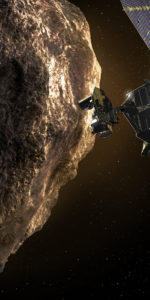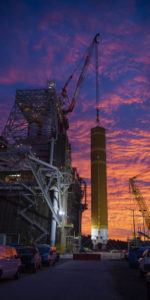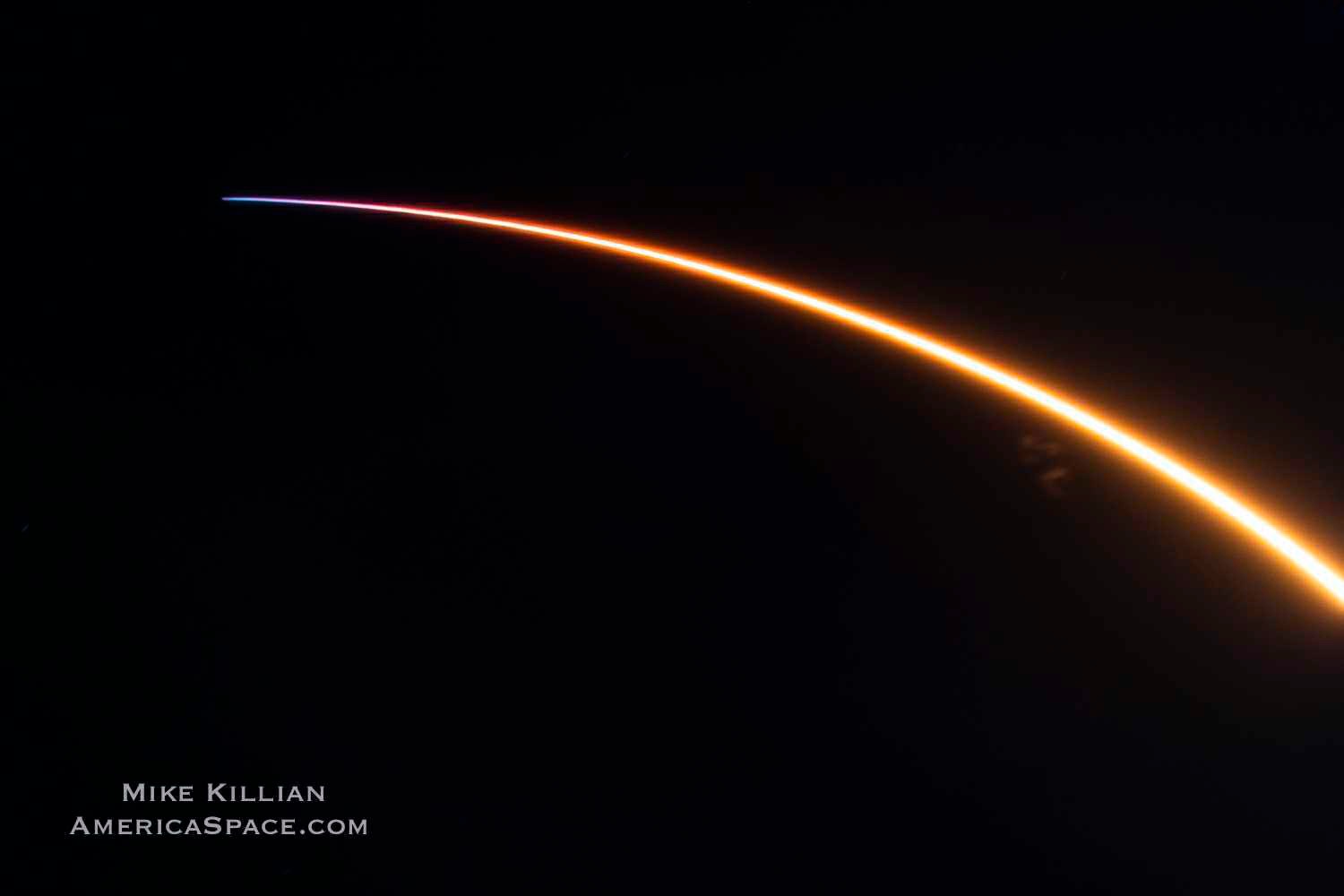
It might seem fitting for a mission snakebitten by the gods of ill-fortune, but the spectacular middle-of-the-night liftoff of SpaceX’s 90th Falcon 9 at 1:12 a.m. EDT Friday also marked its 13th launch in this most unfortunate year of 2020. And it marked the resumption of launches of the Hawthorne, Calif.-based organization’s home-grown Starlink internet communications satellites into low-Earth orbit after almost two months of hiatus.
In the first half of the year, no fewer than seven “batches” of Starlinks—a total of 418 satellites—were boosted smoothly into orbit, in some cases as frequently as twice per month. Unfortunately, the eighth mission succumbed to no fewer than three scrubbed launch attempts thanks to weather and technical troubles, before finally roaring aloft tonight.
As outlined in AmericaSpace’s preview article, this mission carried 57 flatpacked Starlinks and the Global-7 and Global-8 “rideshare” payloads being trucked aloft on behalf of Spaceflight, Inc.’s customer, BlackSky, Inc. Devoted to Earth observations, they are part of a system which should evolve into a 60-strong constellation. It is hoped that the Global birds—two of which (Global-1 and Global-2) rode to orbit aboard a Falcon 9 during the SSO-A SmallSat Express mission in December 2018 and, more recently, another two (Global-3 and Global-4) atop an Elektron-KS booster in June 2019—will provide a ground-imaging resolution as fine as 3.3 feet (1 meter) from an altitude of 310 miles (500 km) and rapidly revisit the same locations on Earth. Meanwhile, the out-of-numerical-sequence Global-5 and Global-6 are currently awaiting launch atop India’s Small Satellite Launch Vehicle (SSLV) out of Satish Dhawan Space Centre in Sriharikota, within Andhra Pradesh, later this year.
According to Spaceflight, this mission is designated “SXRS-1”, in recognition of its nature as the first SpaceX Rideshare. And in June the company announced that it had inked agreements with SpaceX “to secure rideshare capacity on multiple launches”, which will permit the manifesting of payloads on “several” Falcon 9 missions through late 2021.
According to data provided by the 45th Weather Squadron at Patrick Air Force Base, launch initially appeared targeted for Thursday, but was eventually moved to Friday, with a backup attempt booked on the Eastern Range for Saturday. Weather conditions for tonight’s attempt were predicted to be 70-percent-favorable, climbing to 80 percent in the event of a scrub to Saturday.
“Weak high pressure is building across the area with light winds allowing the east coast sea-breeze to develop each afternoon,” the 45th noted in its Thursday update. “Lingering tropical moisture will result in higher shower and storm coverage, with the best chances in the afternoon to evening hours as the sea-breeze moves inaldn, though some overnight activity cannot be ruled out.” All told, the primary violating factors for Thursday were a potential infringement of the Thick Cloud Layer Rule and Cumulus Cloud Rule.
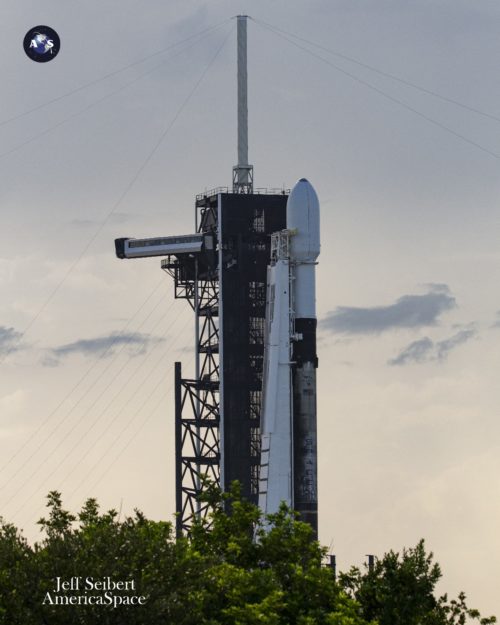
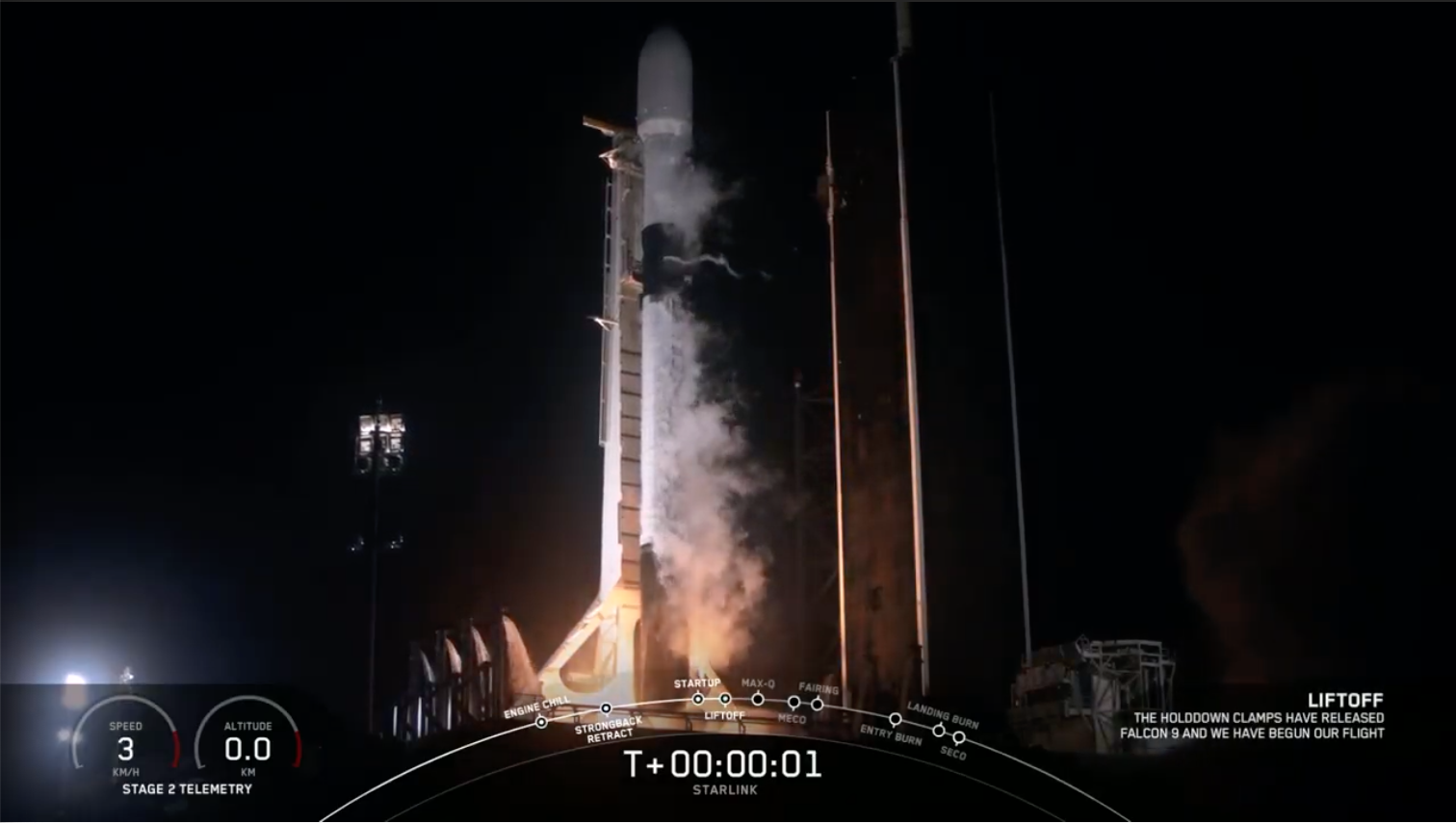
In the meantime, the blackened and scorched B1051 first stage—one of only five Falcon 9 cores to have completed four previous missions and set to become only the third to launch a fifth time—was returned to historic Pad 39A at the Kennedy Space Center (KSC) in Florida on Thursday and raised to the vertical. Teamed with a sparkling-new second stage and payload fairing, the booster commenced fueling with liquid oxygen and a highly refined form of rocket-grade kerosene (known as “RP-1”) at T-35 minutes.
“Here we go,” Spaceflight, Inc., tweeted Thursday. “Launch night!”
Liftoff at 1:12 a.m. EDT began SpaceX’s fourth mission of the year in the hours of darkness, as B1051 pierced the night sky and powered uphill with pinpoint precision.
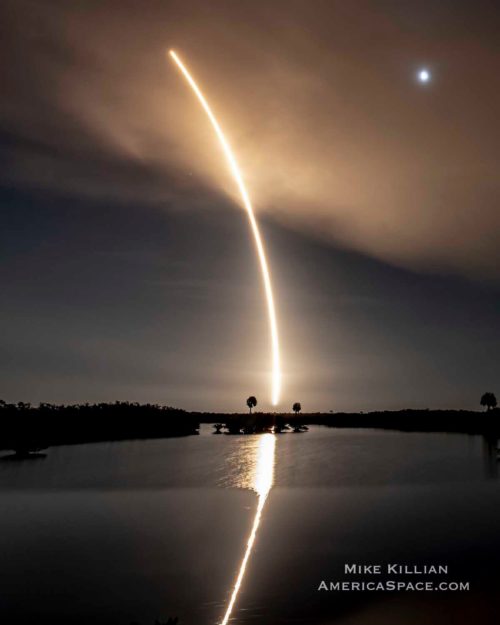
Two and a half minutes into flight, the core stage separated and began its descent to a smooth 1:20 a.m. EDT touchdown on the Autonomous Spaceport Drone Ship (ASDS), “Of Course I Still Love You”, situated offshore in the Atlantic Ocean. Meanwhile, the Merlin 1D+ Vacuum engine of the Falcon 9’s second stage performed a six-minute “burn” to insert its primary payloads into orbit.
“What a landing!” Spaceflight, Inc., tweeted its 14,600 followers as B1051 made a safe return to Earth for the fifth time.
Efforts to catch both fairing halves by the recovery vessels “Ms. Tree” and “Ms. Chief” were unsuccessful.
The two BlackSky birds were successfully deployed a little over an hour into tonight’s flight, followed by the Starlinks at 93 minutes after liftoff.
Ninety missions (albeit with one in-flight failure, back in June 2015) in a decade of operational service has positioned the “single-stick” Falcon 9 as the most-flown booster in current operational service. Its payload capacity to low-Earth orbit has more than doubled, its capacity to geostationary altitude has almost done the same and incremental successes juxtaposed with several near-misses have allowed it to cement its credentials as a versatile rocket capable of repeat launches, oceanic and ground landings, fairing reuse and even the reuse of Dragon capsules.
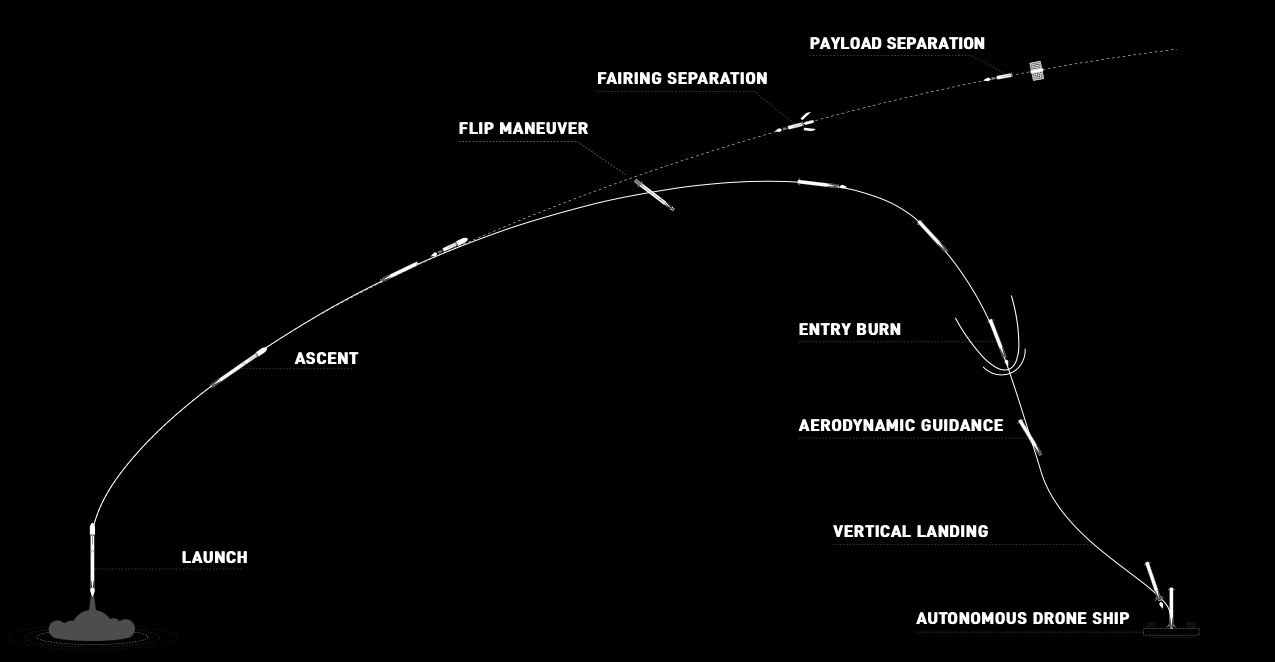
Thirty-three large communications satellite have been boosted to geostationary transfer orbit, together with 75 Iridium NEXT birds and more than 500 Starlinks. Four major Earth observation missions—the joint NASA/NOAA Jason-3, Taiwan’s Formosat-5, Argentina’s SAOCOM-1A and most recently Canada’s Radarsat Constellation Mission (RCM)—have flown, as well as the Transiting Exoplanet Survey Satellite (TESS) and Israel’s ill-fated Beresheet lunar lander to explore the furthest and closest worlds to us.
SpaceX’s classified national security customers among those 90 missions have included NROL-76 for the National Reconnaissance Office, the X-37B mini-shuttle and the highly secretive Zuma mission, whose purpose and exact status came into some doubt within days of its January 2018 launch.
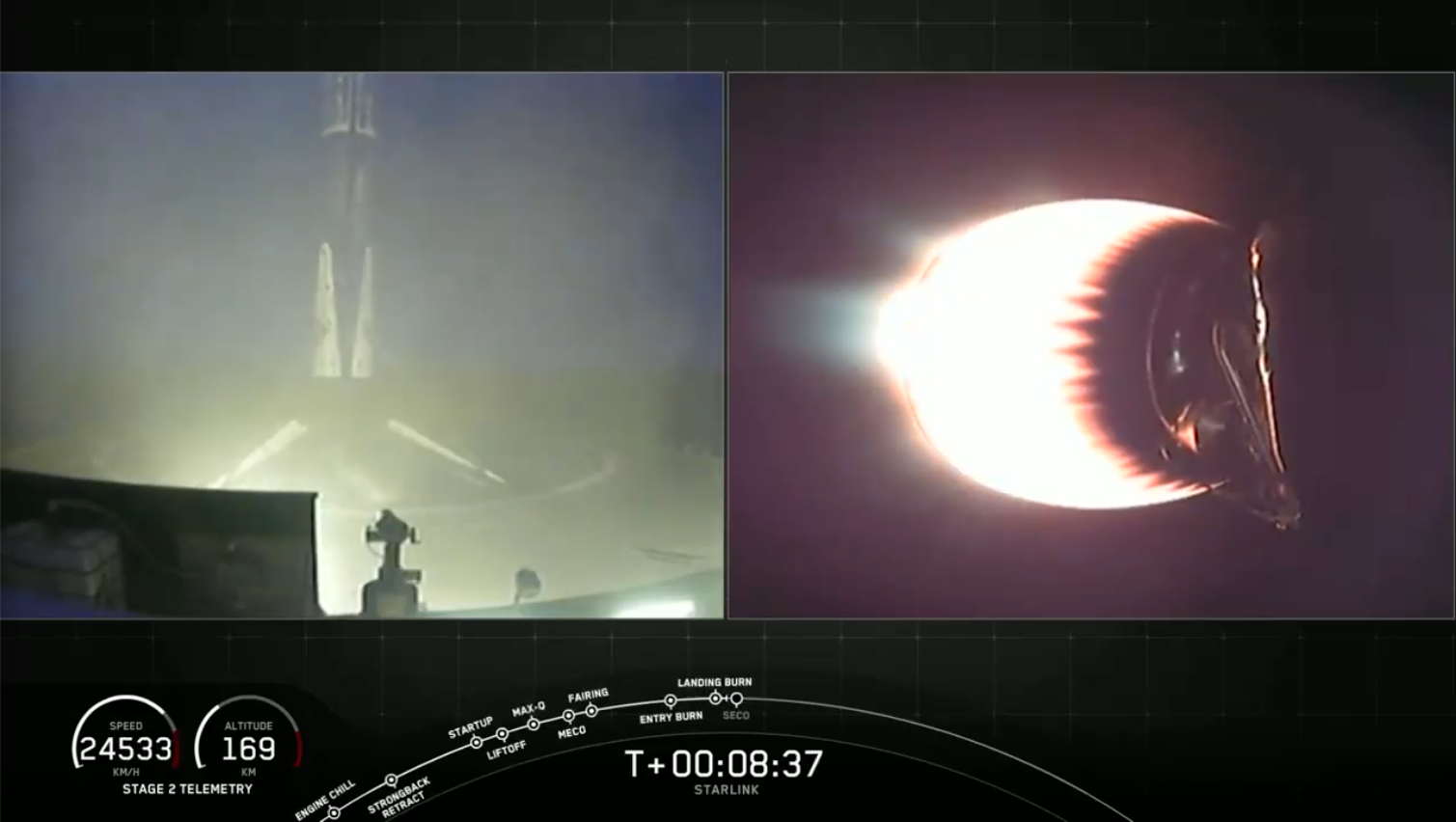
More recently, the Falcon 9 has kicked off Commercial Crew in fine style with the long-awaited Demo-1 mission in March 2019, the dramatic In-Flight Abort Test last January—the first Falcon 9 never intended to achieve orbit—and the triumphant Demo-2 voyage of Dragon Endeavour crewmen Doug Hurley and Bob Behnken. Its launch rate, too, is increasing. It took the Falcon 9 over six years to achieve its 25th flight in 2016, but went on to hit the magical 50 only two years later in 2018, then passed 75 late last fall. Passing 90 launches with today’s flight, the coming months the magical centenary should be reached within the next few months.
.
.
FOLLOW AmericaSpace on Facebook and Twitter!
.
.




